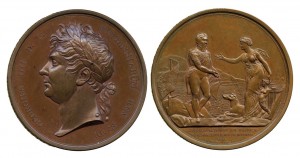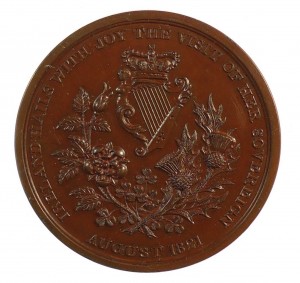‘Ireland hails with joy the visit of her sovereign’— royal medallions
Published in Artefacts, Issue 6 (November/December 2015), Volume 23
A medallion (front and back) commemorating George IV’s landing at Howth in 1821. He left from Dunleary, which was con

‘Ireland hails with joy the visit of her sovereign—August 1821.’
On 12 August 1821 a corpulent George IV set foot on Ireland at Howth, the first peacetime visit by a British monarch. A medallion (below) proclaimed that ‘Ireland hails with joy the visit of her sovereign’. Commemorative medallions were produced for royal visits, suggesting that the Irish were loyal to the Crown but led astray by politicians, a dichotomy explored in James H. Murphy’s Abject loyalty: nationalism and monarchy in Ireland during the reign of Queen Victoria. Visits by George IV and by Victoria in 1849 may have been popularly acclaimed events. Her 1900 visit, however, albeit with decorations and crowds, incurred critical hostility.
Medallions varied from fine and valuable to cheap and cheerful. Artistic quality was often higher than for currency; medallions did not have to stack, permitting raised features, and production was not restricted to the Royal Mint. A medallion of George IV’s landing at Howth (above) shows him being welcomed by Hibernia with harp and hound, and behind her arm a view of Dublin—the steeple of St Patrick’s Cathedral and the dome of the Four Courts. Copper examples were made with ore from mines in County Wicklow.
Royal medallions provide images of the monarch on tour, expressions of welcome and symbolic images on reverse sides, such as the herbaceous—shamrocks, thistles and a rose, often centred, indicating English dominance—or symmetry of shape. Harps featured, crowned or not, from the winged figure to the clársach. Hibernia, classically dressed, figures more on earlier medallions. As with harps, Hibernia changes and develops into the figure of Érin, more plaintive, usually barefooted and surrounded with ruins of past glories. The Irish language rarely features.
Most royal medallions are found for the 1821 and 1849 visits, fewer for later. This might have more to do with the availability of cheaper china souvenirs of jubilees and coronations from English potters than with changes in appreciation for a Victoria, an Edward or a George. Victoria, with Albert, visited in 1849, towards the end of the Famine. One medallion proclaimed: ‘Every heart throbs with hope for the future: the first visit by a British queen to Ireland’.
John Stocks Powell is the retired librarian of York Minster Library.
















